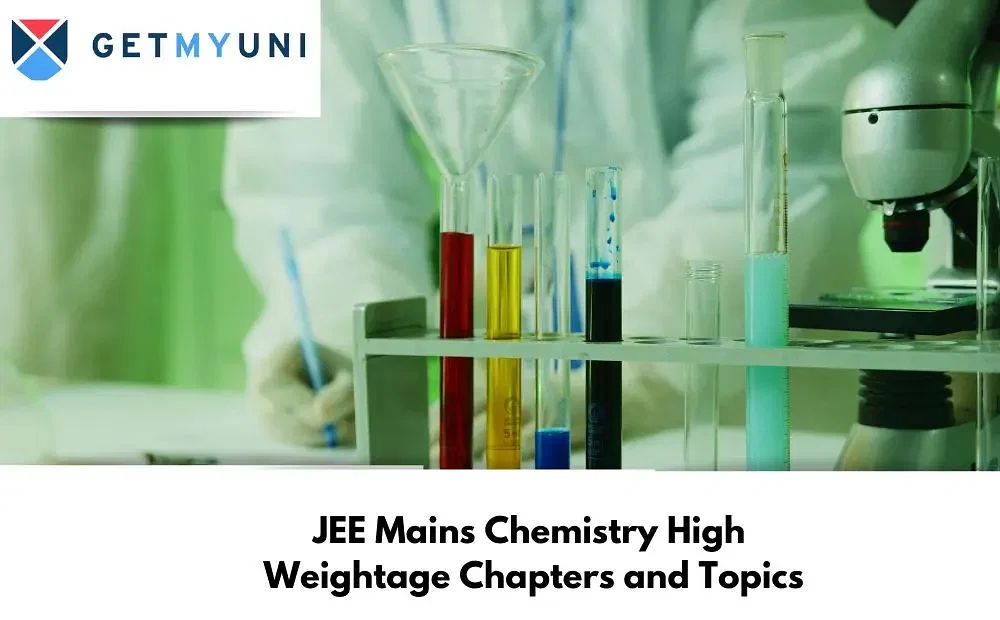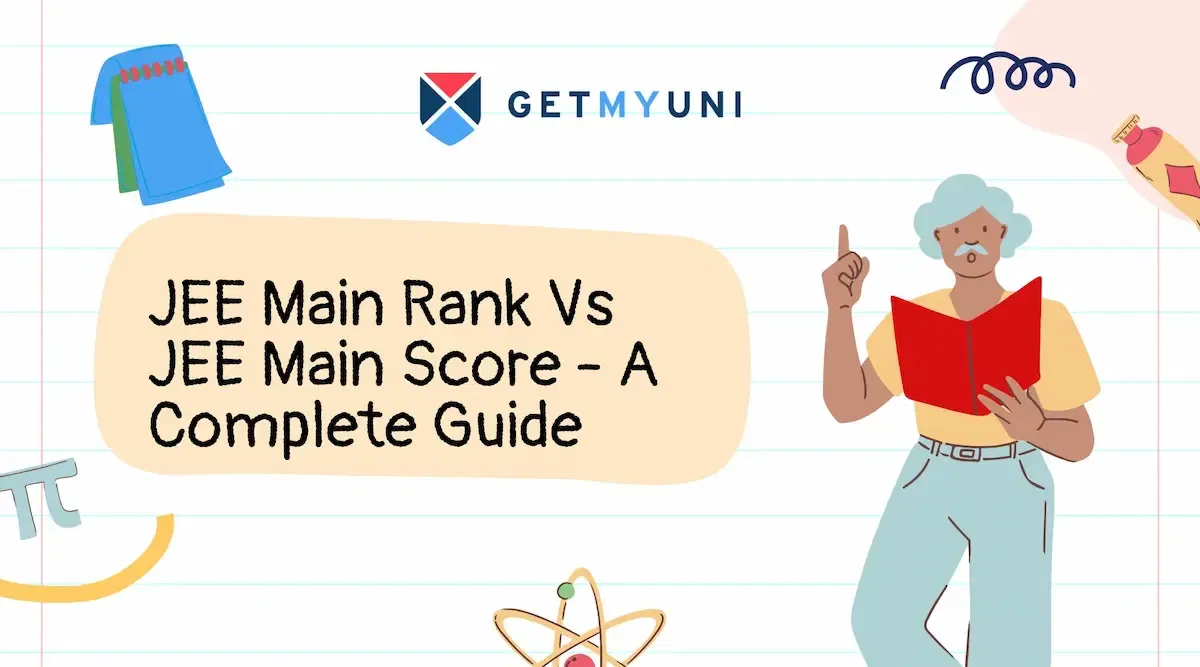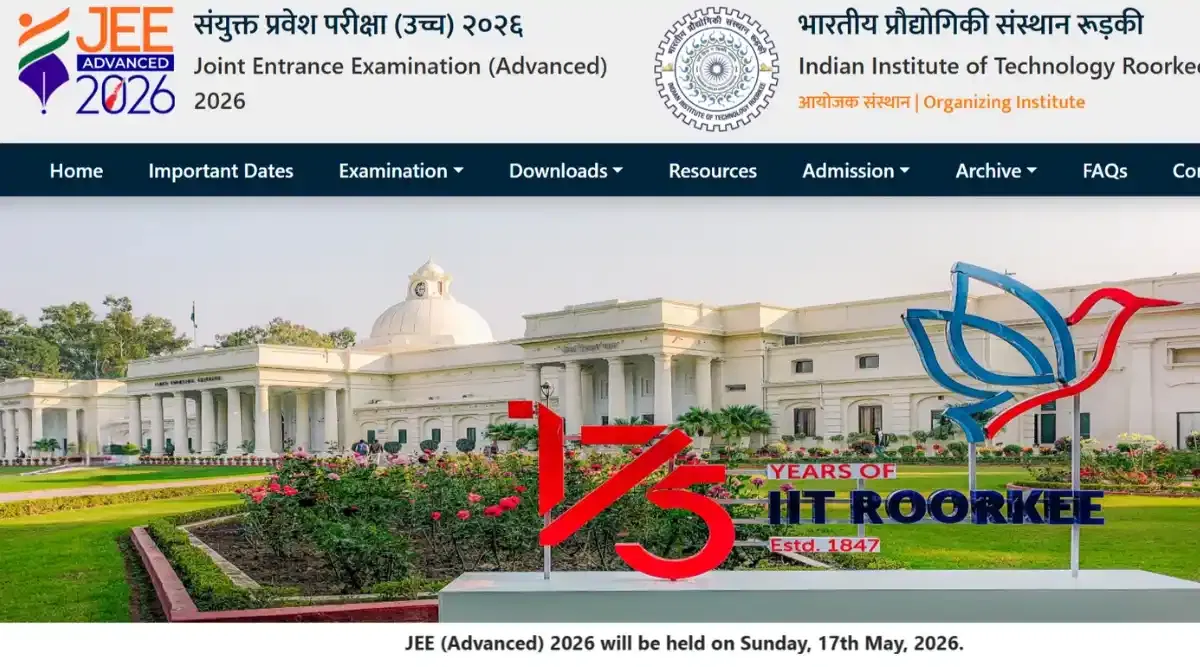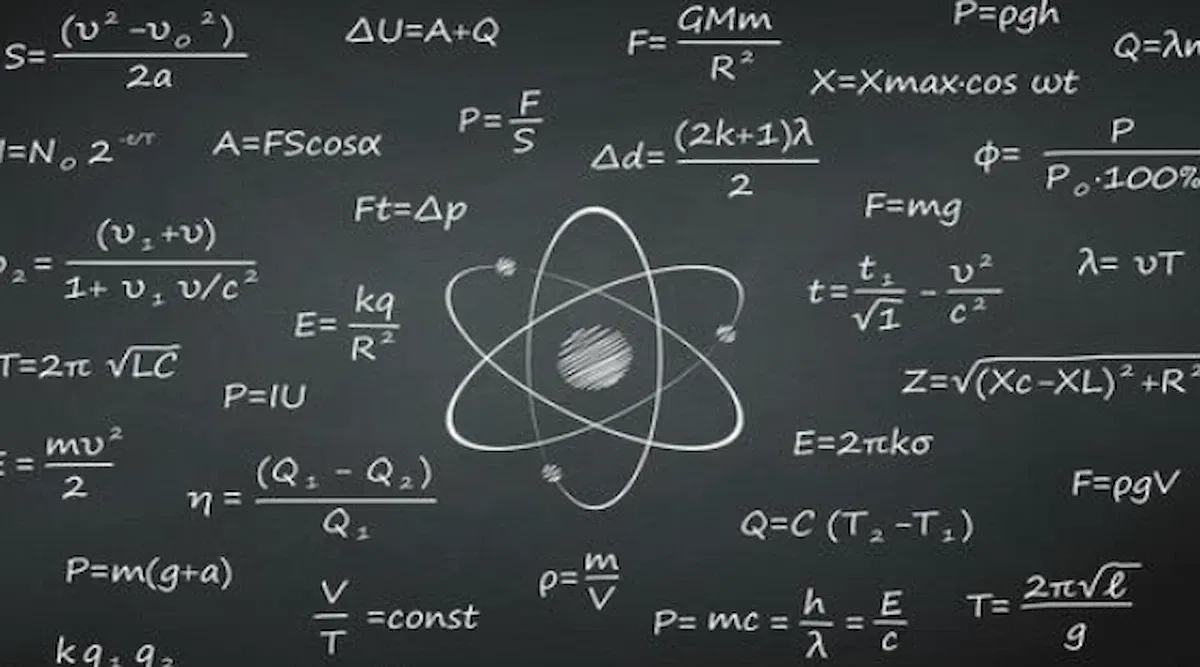JEE Mains Chemistry High Weightage Chapters are from organic, inorganic, and physical chemistry in chronology. The highest scores are Transition Elements and Coordination Chemistry, Periodic Table and Representative Elements, and Thermodynamics.
Table of Contents
The JEE Mains Chemistry High Weightage Chapters, according to the JEE Mains Chemistry Syllabus 2026, are Transition Elements and Coordination Chemistry, Periodic Table and Representative Elements, Thermodynamics and Gaseous State, Atomic Structure, Chemical Bonding, Ionic and Chemical Equilibrium, Nuclear Chemistry and Environment, Solid state and many others. You are advised to refer to the JEE Main Chemistry important topics and chapters to ace the JEE Main exam.
JEE Main Chemistry High Weightage Chapters
The total number of chapters, questions, and the corresponding weightage in descending order are tabulated below for the JEE Mains Chemistry High Weightage Chapters according to the NCERT textbooks. Before preparing, reviewing the weightage of chapters in JEE Main is advisable to comprehend the question’s format.
| Chapters | Total Questions | Weightage |
| Transition Elements and Coordination Chemistry | 3 | 12 |
| Periodic Table and Representative Elements | 3 | 12 |
| Thermodynamics and Gaseous state | 2 | 8 |
| Atomic Structure | 2 | 8 |
| Chemical Bonding | 2 | 8 |
| Ionic and Chemical Equilibrium | 2 | 8 |
| Nuclear chemistry and Environment | 2 | 8 |
| Solid state and surface chemistry | 2 | 8 |
| Redox reaction | 1 | 4 |
| Mole concept | 1 | 4 |
| Chemical Kinetics | 1 | 4 |
| Electrochemistry | 1 | 4 |
| General Organic chemistry | 1 | 4 |
| Solution and Colligative properties | 1 | 4 |
| Hydrocarbon | 1 | 4 |
| Stereochemistry | 1 | 4 |
| Alkyl Halides | 1 | 4 |
| Aromatic Compounds | 1 | 4 |
| Carboxylic acid and its derivatives | 1 | 4 |
| Carbohydrates, amino acid and Polymers | 1 | 4 |
Also Read: JEE Main Chemistry Important Formulas 2026 - Download PDF
Highest Scoring Topics in JEE Main Chemistry
The highest-scoring Chemistry topics of JEE Mains Chemistry High Weightage Chapters for the JEE Main exam are Gaseous State, Chemical Kinetics, and General Organic Chemistry. The sub-topics of all these topics are listed below:
Gaseous State:
- Gaseous State: Measurable properties of gases; Gas laws – Boyle'sBoyle's law, Charles'sCharles's law, Graham'sGraham's law of diffusion, Avogadro'sAvogadro's Law, Dalton'sDalton's Law of partial pressure.
- The concept of the absolute scale of temperature, Ideal gas equation, and kinetic theory of gases (only postulates).
- The concept of average, root mean square and most probable velocities.
- Real gases, deviation from Ideal behaviour, compressibility factor, van der Waals equation, liquefaction of gases, critical constants.
- Liquid State: Properties of liquids – vapour pressure, viscosity surface tension and effect of temperature on them (qualitative treatment only).
- Solid State: Classification of solids: molecular, ionic, covalent, metallic, amorphous, and crystalline solids (elementary idea).
- Bragg'sBragg's Law and its applications.
- Unit cell and lattices, packing in solids (fcc, bcc and hcp lattices), voids, calculations involving unit cell parameters, and imperfections in solids.
- Electrical, magnetic and dielectric properties.
Chemical Kinetics:
- The rate of a chemical reaction and factors affecting the rate of reactions: concentration, temperature, pressure, and catalyst.
- Elementary and complex reactions, order and molecularity of reactions, rate law, rate constant and its units, differential and integral forms of zero and first-order reactions, their characteristics and half-lives, and the effect of temperature on the rate of reactions.
- Arrhenius theory, activation energy and its calculation, collision theory of bimolecular gaseous reactions (no derivation).
Also Read: JEE Main Preparation Tips for Chemistry 2026
General Organic Chemistry:
- Tetravalency of carbon; Shapes of simple molecules – hybridization (s and p).
- Classification of organic compounds based on functional groups: -C = C- and those containing halogens, oxygen, nitrogen, and sulphur; Homologous series.
- Isomerism: structural and stereoisomerism.
- Nomenclature (Trivial and IUPAC): Covalent bond fission Homolytic and heterolytic: free radicals, carbocations, and carbanions; stability of carbocations and free radicals, electrophiles and nucleophiles.
- Electronic displacement in a covalent bond: Inductive effect, electromeric effect, resonance, and hyperconjugation.
- Common types of organic reactions: Substitution, addition, elimination, and rearrangement.
- Classification, isomerism, IUPAC nomenclature, general preparation methods, properties and reactions.
- Alkanes: Conformations; Sawhorse and Newman projections (of ethane); Mechanism of halogenation of alkanes.
- Alkenes: Geometrical isomerism.
- Mechanism of electrophilic addition: addition of hydrogen, halogens, water, hydrogen halides (Markownikoff's and peroxide effect); Ozonolysis, oxidation, and polymerization.
- Alkynes: Acidic character; Addition of hydrogen, halogens, water and hydrogen halides; Polymerization.
- Aromatic hydrocarbons: Nomenclature, benzene structure and aromaticity.
- Mechanism of electrophilic substitution: halogenation, nitration, Friedel-Crafts alkylation and acylation, directive influence of the functional group in monosubstituted benzene.
- General methods of preparation, properties, and reactions.
- Nature of C-X bond.
- Mechanisms of substitution reactions.
- Uses, Environmental effects of chloroform, iodoform, freons, and DDT.
- General methods of preparation, properties, reactions, and uses.
- Alcohols: Identification of primary, secondary and tertiary alcohols; mechanism of dehydration.
- Phenols: Acidic nature, electrophilic substitution reactions: halogenation, nitration, sulphonation, Reimer Tiemann reaction.
- Ethers: Structure.
- Aldehyde and Ketones: Nature of carbonyl group; Nucleophilic addition to >C=O group, relative reactivities of aldehydes and ketones.
- Important reactions such as nucleophilic addition reactions (addition of HCN, NH3 and its derivatives), Grignard reagent, oxidation, reduction (Wolff Kishner and Clemmensen), the acidity of hydrogen, aldol condensation, Cannizzaro reaction, Haloform reaction.
- Chemical tests to distinguish between aldehydes and ketones.
- Carboxylic Acids: Acidic strength and factors affecting it.
More Accessible Topics for JEE Chemistry that are High Scoring
The easy topics of JEE Mains Chemistry High Weightage Chapters that are also high scoring are Chemical Bonding and Molecular Structure, Chemical Thermodynamics, Solutions, and Equilibrium. Students are advised to carefully prepare each subtopic to score good marks in the subject.
Chemical Bonding and Molecular Structure:
- Kossel–Lewis approach to chemical bond formation, the concept of ionic and covalent bonds.
- Ionic Bonding: Formation of ionic bonds, factors affecting the formation of ionic bonds, calculation of lattice enthalpy.
- Covalent Bonding: Concept of electronegativity, Fajan's rule, dipole moment; Valence Shell Electron Pair Repulsion (VSEPR) theory and shapes of simple molecules.
- Quantum mechanical approach to covalent bonding: Valence bond theory, Its important features, the concept of hybridization involving s, p, and d orbitals; Resonance.
- Molecular Orbital Theory: Its important features, LCAOs, types of molecular orbitals (bonding, antibonding), sigma and pi-bonds, molecular orbital electronic configurations of homonuclear diatomic molecules, the concept of bond order, bond length and bond energy.
- Elementary idea of metallic bonding, Hydrogen bonding, and its applications.
Read More: Most Easy and Scoring Chapters for JEE Main 2026
Chemical Thermodynamics:
- Fundamentals of thermodynamics: System and surroundings, extensive and intensive properties, state functions, types of processes.
- First Law of thermodynamics: Concept of work, heat internal energy, and enthalpy, heat capacity, molar heat capacity
- Hess'sHess's Law of constant heat summation.
- Enthalpies of bond dissociation, combustion, formation, atomization, sublimation, phase transition, hydration, ionisation, and solution.
- The second Law of thermodynamics: Spontaneity of processes; Delta S of the universe and Delta G of the system as criteria for spontaneity, Delta Go (Standard Gibbs energy change) and equilibrium constant.
Solutions:
- Different methods for expressing the concentration of a solution: molality, molarity, mole fraction, percentage (by volume and mass both), the vapour pressure of solutions and Raoult's Law.
- Ideal and non-ideal solutions, vapour pressure – composition, plots for ideal and non-ideal solutions.
- Colligative properties of dilute solutions, relative lowering of vapour pressure, depression of freezing point, elevation of boiling point and osmotic pressure.
- Determination of molecular mass using colligative properties.
- Abnormal value of molar mass, Hoff factor, and its significance.
Equilibrium:
- The meaning of equilibrium is the concept of dynamic equilibrium.
- Equilibria involving physical processes: Solid-liquid, liquid-gas – gas and solid-gas equilibria, Henry's Law, a general characteristic of equilibrium involving physical processes.
- Equilibria involving chemical processes: Law of chemical equilibrium, equilibrium constants (Kp and Kc) and their significance, the significance of Delta G and Delta Go in chemical equilibria, factors affecting equilibrium concentration, pressure, temperature, and the effect of the catalyst.
- Le Chatelier's principle.
- Ionic equilibrium: Weak and strong electrolytes, ionisation of electrolytes, various concepts of acids and bases (Arrhenius, Bronsted-Lowry and Lewis) and their ionisation, acid-base equilibria (including multistage ionisation) and ionisation constants, ionisation of water, pH scale, common ion effect, hydrolysis of salts and pH of their solutions, solubility of sparingly soluble salts and solubility products, buffer solutions.
Also Check: Important Topics for JEE Main and Advanced 2026
JEE Main 2026 Recommended Books for Chemistry
The recommended books for preparing JEE Mains Chemistry High Weightage Chapters are listed below, and students are advised to study and solve all the questions correctly to excel in the exam.
- NCERT Textbooks for classes 11 and 12 by NCERT
- Modern Approach to Chemical Calculations by R.C. Mukherjee
- Organic Chemistry by O P Tandon
- Concept of Physical Chemistry by P Bahadur
- Concise Inorganic Chemistry by J D Lee
- Physical Chemistry by P.W. Atkins
Also Read: Electrochemistry Formulas for JEE Main 2026
You should mainly focus on high-weightage topics which will help you gain a good score rise. The above recommended books and topics will help you to list out the important topics that needs to be prepared and revised before giving the JEE Main Exam.







![Indian Institute of Technology, [IIT] Kanpur](https://media.getmyuni.com/azure/college-image/small/indian-institute-of-technology-iit-kanpur.jpg)
![Indian Institute of Technology, [IIT] Roorkee](https://media.getmyuni.com/azure/college-image/small/indian-institute-of-technology-iit-roorkee.jpg)
![Jawaharlal Nehru University, [JNU] New Delhi](https://media.getmyuni.com/azure/college-image/small/jawaharlal-nehru-university-jnu-new-delhi.jpg)
![University of Calcutta, [UC] Kolkata](https://media.getmyuni.com/azure/college-image/small/university-of-calcutta-uc-kolkata.jpg)





























POST YOUR COMMENT